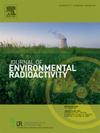作为湖泊地下水排放示踪剂的镭同位素:回顾与展望
IF 1.9
3区 环境科学与生态学
Q3 ENVIRONMENTAL SCIENCES
引用次数: 0
摘要
湖泊地下水排放(LGD)是湖泊水文收支的重要组成部分,是湖泊营养物质和污染物的重要来源。自然存在的放射性镭同位素(223Ra, 224Ra, 226Ra, 228Ra)由于其独特的地球化学性质而成为研究湖泊地下水排放的有价值的示踪剂。虽然镭同位素过去主要用于海底地下水排放的研究,但其“盐效应”特征已日益使其成为确定和量化低密度地下水排放的重要工具。本文综述了镭同位素示踪在湖泊地下水排放中的应用和研究进展,包括湖泊地下水排放的相关概念和方法、镭同位素的地球化学特征、湖泊地下水排放过程中镭同位素示踪技术的发展,以及地下水排放过程中镭的来源识别和定量策略。此外,本文还指出了在LGD研究中应用镭同位素示踪技术所遇到的一些限制和挑战,并概述了未来的研究方向,以加强镭同位素的定量研究。本文章由计算机程序翻译,如有差异,请以英文原文为准。
Radium isotopes as tracers of lacustrine groundwater discharge: Review and prospects
Lacustrine groundwater discharge (LGD) is a crucial component of lake hydrological budgets and serves as a significant source such as nutrients and pollutants. Naturally occurring radioactive radium isotopes (223Ra, 224Ra, 226Ra, 228Ra) have emerged as valuable tracers for studying lacustrine groundwater discharge due to their distinctive geochemical properties. While radium isotopes were primarily utilized in studies of submarine groundwater discharge in the past, their "salt effect" characteristics have increasingly established them as essential tools for identifying and quantifying LGD. This review focuses on the application and research advancements of radium isotopes in tracing LGD, encompassing concepts and methodologies related to lacustrine groundwater discharge, the geochemical characteristics of radium isotopes, the development of radium isotope tracing techniques for LGD, and strategies for source identification and quantification of radium in the groundwater discharge process. Furthermore, this review addresses several limitations and challenges encountered in the application of radium isotope tracing techniques for LGD research and outlines future research directions that could enhance the quantitative study of radium isotopes.
求助全文
通过发布文献求助,成功后即可免费获取论文全文。
去求助
来源期刊

Journal of environmental radioactivity
环境科学-环境科学
CiteScore
4.70
自引率
13.00%
发文量
209
审稿时长
73 days
期刊介绍:
The Journal of Environmental Radioactivity provides a coherent international forum for publication of original research or review papers on any aspect of the occurrence of radioactivity in natural systems.
Relevant subject areas range from applications of environmental radionuclides as mechanistic or timescale tracers of natural processes to assessments of the radioecological or radiological effects of ambient radioactivity. Papers deal with naturally occurring nuclides or with those created and released by man through nuclear weapons manufacture and testing, energy production, fuel-cycle technology, etc. Reports on radioactivity in the oceans, sediments, rivers, lakes, groundwaters, soils, atmosphere and all divisions of the biosphere are welcomed, but these should not simply be of a monitoring nature unless the data are particularly innovative.
 求助内容:
求助内容: 应助结果提醒方式:
应助结果提醒方式:


